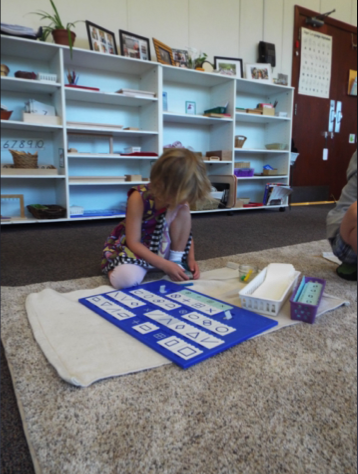The Uninterrupted Work Cycle – The Basics of Success
A Montessori teacher put it this way: “Protect the three-hour work period with your life! It’s one of the most important ingredients in our method.”
Parents! Exciting things are happening around here. Already, we are beginning to see the inklings of classrooms running like well-oiled machines. Below you will find a very meaningful article about the uninterrupted work cycle. While this sounds like more fancy Montessori-esque language, it has great meaning in a successful Montessori environment. This is the place where the students natural instincts to find meaningful learning experiences is most honored to prepare the child for future learning opportunities. This is where one child’s need for movement is given as much respect and space as another child’s need for full concentration on a task. This is where Montessori shines like a bright star in a sky full of educational opportunities for kiddos. I hope you’ll take just a few short minutes to read below and learn why we want so badly for your child to arrive to school on time each and every day and what great opportunities this important beginning of day time has to offer your child.
Warmly,
Britney
“When the children had completed an absorbing bit of work,
they appeared rested and deeply pleased.”
—Maria Montessori (author), Paul Oswald (editor),
Basic Ideas of Montessori’s Educational Theory

Children as young as three-years-old, after several months in a Montessori classroom, are able to choose their own work and focus on and finish their tasks. Through observation and experimentation, Montessori discovered the importance of a two-and-a-half to three-hour uninterrupted work period. The last hour of a lengthy work period is usually when children are most likely to choose challenging work and concentrate deeply.
Montessori once observed a three-year-old repeat the knobbed cylinders activity 44 times. The girl’s concentration did not waver when Montessori tested it, first picking up the girl in her chair and placing her (still in her chair) on top of her desk and then asking classmates to sing. When she stopped working of her own accord, “…she looked round with a satisfied air, almost as if waking from a refreshing nap.” Montessori called this a “never-to-be-forgotten” discovery. (Spontaneous Activity in Education)
Phases of the Work Period
Montessori and her directresses carefully observed the phases of children’s work during long work periods. They noted that in the first hour and twenty minutes children often chose an easy initial task, followed by a moderately challenging activity. After this, ten minutes of “false fatigue” occurred as children appeared restless and classroom noise increased. This is the time when many teachers get uneasy and end the work period. However, false fatigue is actually “preparation for the culminating work,” when children choose challenging work and concentrate deeply. When finished, there is a period of “contemplation” as children appear deeply satisfied and at peace. (ibid)
False fatigue is similar to adults taking a coffee break after working hard. If children are disrupting others, they can be quietly redirected, but too much interference actually prolongs the period of false fatigue. Instead of anxiously over-controlling or ending the work period, we must trust children to return to work. We can then observe whether they choose their most challenging task of the day.
